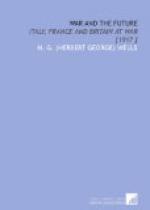For my own part I never imagined the land ironclad idea would get loose into war. I thought that the military intelligence was essentially unimaginative and that such an aggressive military power as Germany, dominated by military people, would never produce anything of the sort. I thought that this war would be fought out without Tanks and that then war would come to an end. For of course it is mere stupidity that makes people doubt the ultimate ending of war. I have been so far justified in these expectations of mine, that it is not from military sources that these things have come. They have been thrust upon the soldiers from without. But now that they are loose, now that they are in war, we have to face their full possibilities, to use our advantage in them and press on to the end of the war. In support of a photo-aero directed artillery, even our present Tanks can be used to complete an invisible offensive. We shall not so much push as ram. It is doubtful if the Germans can get anything of the sort into action before six months are out. We ought to get the war on to German soil before the Tanks have grown to more than three or four times their present size. Then it will not matter so much how much bigger they grow. It will be the German landscape that will suffer.
After one has seen the actual Tanks it is not very difficult to close one’s eyes and figure the sort of Tank that may be arguing with Germany in a few months’ time about the restoration of Belgium and Serbia and France, the restoration of the sunken tonnage, the penalties of the various Zeppelin and submarine murders, the freedom of seas and land alike from piracy, the evacuation of all Poland including Posen and Cracow, and the guarantees for the future peace of Europe. The machine will be perhaps as big as a destroyer and more heavily armed and equipped. It will swim over and through the soil at a pace of ten or twelve miles an hour. In front of it will be corn, land, neat woods, orchards, pasture, gardens, villages and towns. It will advance upon its belly with a swaying motion, devouring the ground beneath it. Behind it masses of soil and rock, lumps of turf, splintered wood, bits of houses, occasional streaks of red, will drop from its track, and it will leave a wake, six or seven times as wide as a high road, from which all soil, all cultivation, all semblance to cultivated or cultivatable land will have disappeared. It will not even be a track of soil. It will be a track of subsoil laid bare. It will be a flayed strip of nature. In the course of its fighting the monster may have to turnabout. It will then halt and spin slowly round, grinding out an arena of desolation with a diameter equal to its length. If it has to retreat and advance again these streaks and holes of destruction will increase and multiply. Behind the fighting line these monsters will manoeuvre to and fro, destroying the land for all ordinary agricultural purposes for ages to come. The first imaginative account of the land ironclad that was ever written concluded with the words, “They are the reductio ad absurdum of war.” They are, and it is to the engineers, the ironmasters, the workers and the inventive talent of Great Britain and France that we must look to ensure that it is in Germany, the great teacher of war, that this demonstration of war’s ultimate absurdity is completed.




